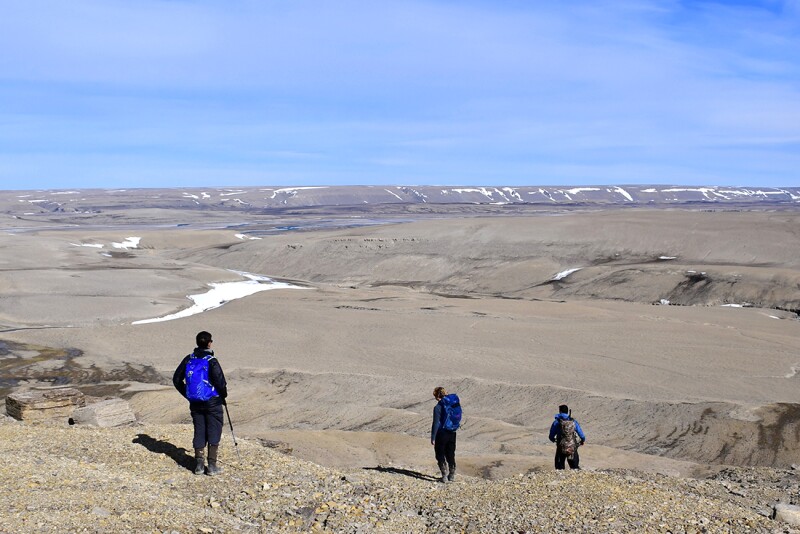Some trips begin with a book, and my guess is that Barry Lopez’s best seller and National Book Award winner, Arctic Dreams, has launched more than a few expeditions to the frozen regions at the top of the globe. His portrait of the Arctic, and the peoples who live there, had led me to want to see that part of the world ever since I first picked it up a few years ago, on a trip to Churchill in Manitoba. Churchill doesn’t count as the Arctic and is instead a town on the southern edges of the world that Lopez describes, and I wondered what I would find if I continued farther north.
“We tend to think of places like the Arctic, the Antarctic, the Gobi, the Sahara, the Mojave, as primitive, but there are in fact no primitive or even primeval landscapes,” Lopez writes. “And nowhere is the land empty or undeveloped…. The land, an animal that contains all other animals, is vigorous and alive.”
I wanted to see this land that might appear barren at first sight, and then learn to give it a second look, to spot the small wildflowers and the elusive foxes, hares, and lemmings. When earlier this year I was asked if I would be interested in visiting Somerset Island in the Canadian territory of Nunavut as part of AFAR’s partnership with the USTOA, I leapt at the chance. (USTOA, for those who aren’t familiar with the organization, is the United States Tour Operators Association, whose members provide travelers with unparalleled access, insider knowledge, and peace of mind to destinations across the globe.)
I’d travel with Quark Expeditions on their itinerary to the Arctic Watch Wilderness Lodge in July, when the midnight sun never sets and the Arctic ice is finally melting.
Even just meeting up with the rest of the group was an odyssey, requiring three flights to get to Yellowknife, the capital of the Northwest Territories. Then a fourth flight, the next morning, took us to a remote island that is the size of Vermont, yet home to only one seasonal camp, the Arctic Watch Wilderness Lodge with accommodations for 23 guests, and a staff of some 20 employees—guides, cooks, and others.
You know you have arrived in a unique part of the world even while circling the island before touching down. Once we landed, a lunar landscape stretched to our south, while the Northwest Passage and, beyond it, Devon Island were to the north. Our home for the next five nights, a collection of white tents, gleamed atop a bluff overlooking the Cunningham Inlet.

A Thule site near the Northwest Passage
Each day we would divide up, choosing from different activities—tracking polar bears, exploring the island on foot, kayaking among the belugas. On our first day, I joined the excursion to Polar Bear Point. On our way, we stopped at an ancient Thule site. It was modest, a small circle of stones and bones. The history of the Arctic isn’t embodied in soaring architecture but humble camps, and the wonder of the place is found less in built masterpieces than the simple fact that anyone could survive here, when even at the height of summer we were bundled up in parkas. On the outing that day, I also had my first glimpse of what passes for a tree in the Arctic. I’d read about arctic willows but never seen this plant that, even when they are hundreds of years old, grow no taller than a few inches. In a landscape where there is little vegetation competing for sunlight, height isn’t necessary and not particularly advantageous.

A guide and two Quark Expeditions guests near “Google Canyon”
On other days we wandered through some of the island’s dramatic canyons carved by rivers of runoff from melting snow. One was nicknamed Google Canyon by the lodge’s staff as a Google satellite had once dropped from the sky and landed there. Despite the occasional piece of technology falling from the heavens, Somerset Island, like most of Nunavut, shows few traces of mankind. The territory is just a little smaller in area than Alaska and Texas combined, yet it is home to only 36,000 people. It is hard to fathom how many canyons and waterfalls there must be that no has ever set their eyes upon in this vast land.

Beluga whales swimming up the Cunningham Inlet
The Arctic landscape is both epic in its scale—climb one of the peaks of Somerset and you can see for miles—and small in its details. It took the trained eyes of our guides to notice the movements on the horizon that could be a hare or fox cubs gathered around a den. Some sights, however, required no binoculars. Around 2,000 beluga whales gather each summer at the point where the Cunningham River drains into the sea, located right below the Arctic Watch Wilderness Lodge. Watching them from the shore and kayaking among them were highlights of my stay at the lodge. Lopez’s book is not only a meditation on the Arctic, but a call for us to value it. “What every culture must eventually decide is what of all that surrounds it, tangible and intangible, it will dismantle and turn into material wealth,” he writes. “And what it will fight to preserve.” Here on the edges of the continent, hundreds of miles from the nearest human settlement of any size, I’d found a different sort of wealth among the belugas, and one the Arctic Watch Wilderness Lodge helped me learn to value.
You can read more about John’s travels with Quark Expeditions at the USTOA blog.











